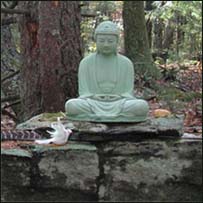|
|
 |
Please support Dharma Seed with a 2025 year-end gift.
Your donations allow us to offer these teachings online to all.

|

|

|
The greatest gift is the
gift of the teachings
|
|

|
| |
|
Dharma Talks
|
2025-08-21
Anapanasati: The Buddha's Teaching on Mindfulness of Breathing
49:31
|
|
James Baraz
|
|
|
Working with the Anapanasati Sutta in some depth. There are 16 steps in four tetrads that the Buddha lays out regarding how to practice this way. It is more than simply keeping one's attention on the experience of breathing. Some of the steps will likely surprise you. I thought it would be interesting to hear how the Buddha himself practiced using the breath and then practice together as he suggested.
Anapanasati Sutta Majjhima Nikaya #118
https://www.accesstoinsight.org/tipitaka/mn/mn.118.than.html
Anåpånasati- Summary of the Four Tetrads (16 steps)
https://docs.google.com/document/d/1yE2GiJtr3nnMGR_2YYOEA7eZ9W02ti52PD5abYF_Ius/edit?tab=t.0
Thich Nhat Hanh
Video TNH explaining the 16 steps (28 minutes)
https://youtu.be/inPkOzo_8XQ?si=nKp94lysBPxn4od_
Ven Analayo
Audio guided meditations successively building on the tetrads. Last one includes all four.
Mindfulness of Breathing with Bhikkhu Anālayo
https://www.buddhistinquiry.org/resources/breathing-audio/
Written Overview
Analayo - Understanding and Practicing the Ānāpānasati-sutta
https://www.dhammawheel.com/viewtopic.php?t=30301
Bhikkhu Bodhi's videos going through the sutta in detail.
https://www.google.com/search?sca_esv=49266cf56d93934f&sxsrf=AE3TifMAPbSxpASPFg4H_3u7YewNOi0UgA:1753423263992&q=Bhikkhu+Bodhi+mn+118&udm=7&fbs=AIIjpHxU7SXXniUZfeShr2fp4giZ1Y6MJ25_tmWITc7uy4KIeiAkWG4OlBE2zyCTMjPbGmP8dNHyekGOBzxjAdPhnrqrkFMVvRmyqhKdJnNaG3AkXT9BEIxM7mvWZQG3bFq0xYNXOHnKszVdt00PEHYlRCcNfQMctmXagH2kmQdDS-r99NNUO7KPPqfaJdzNdnznKA2npV8j&sa=X&ved=2ahUKEwiV_KnWqteOAxVFIxAIHdP6MTkQtKgLKAJ6BAgVEAE&biw=1309&bih=738&dpr=2.2
|
|
Insight Meditation Community of Berkeley
|
|
|
2025-06-29
Q and A
52:19
|
|
Ajahn Sucitto
|
|
|
Q1 - What would you suggest as priorities for lay practice, recollections to establish a steady orientation to Dhamma?; 13:08 Q2 - Mindfulness when talking and using computers etc.; 18:30 Q3 - Energy, qi, anapanasati and integration of energy; 26:24 Q4 – I feel lots of unpleasant skin sensations when sitting, What might these be? 28:46 Q5 You’ve referred to integrating energy as a new way to consider. What does this mean? 36:09 Q9 Why couldn’t it be that nibbana is like chasing the unicorn; 37:23 Q10 Can you speak about wisdom and samadhi; 40:33 Q11 Can you provide some guidance on mudita, rapture (piti) and stability/ staying grounded; 44:52 Q12 Contemplating the arising of the ‘me’ sense, dependent on phenomena.
|
|
Insight Meditation Society - Forest Refuge
:
One Month Retreat at the Forest Refuge
|
|
|
2024-06-18
Q&A
42:24
|
|
Ajahn Sucitto
|
|
|
02:00 Q1 Regarding the sankaras, is it possible for feelings to land on contact without being in the realm of sankaras? If so how would this perception manifest? 17:15 Q2 Could you please explain the distinction between mental formations and consciousness. 30:02 Q3 Some questions on mindfulness of breathing. Should we regulate the breath and use the length of the breath as the object of mindfulness? 38:24 Q4 Can you speak about the third tetrad of the anapanasati sutta.
|
|
Satipanna Insight Meditation (SIMT)
:
A Mindful Resonance
|
|
|
2024-06-03
How to Meditate--The 4 Practices Rooted in Tradition and Confirmed by Neuroscience
56:20
|
|
Tina Rasmussen
|
|
|
How to Meditate--The 4 Practices Rooted in Tradition and Confirmed by Neuroscience.
In this talk, Tina gives concise overview instructions and guidance on how to begin meditating, suitable for beginners and experienced meditators alike. She talks about general guidelines that apply to every type of meditation. Then she gives an overview of the 4 practice categories being studied in neuroscience, which are also reflected in the Buddhist tradion. Then she gives instructions on how to practice each type of meditation, with a short period of practice. To go directly to those sections, please see the following time markers:
-Heart Practices--Bodhicitta and the Bramaviharas (lovingkindness, compassion, joy/gratitude, and equanimity): 15:45
-Focused Attention--Samatha (concentration and serenity), Anapanasati (mindfulness of breathing): 31:03
-Open Monitoring--Vipassana (insight meditation): 39:26
-Self-Transcending--Dzogchen (Rigpa): 49:37
|
|
Luminous Mind Sangha
|
|
|
|
|